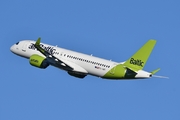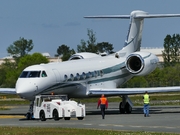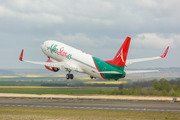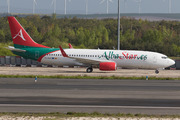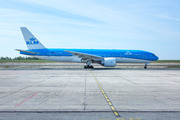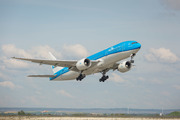Dépêches
Carpenter Technology to Supply Landing Gear Alloy to Goodrich for Next Ten Years
Dépèche transmise le 19 juin 2011 par Business Wire

Carpenter Technology to Supply Landing Gear Alloy to Goodrich for Next Ten Years
WYOMISSING, Pa.--(BUSINESS WIRE)--Carpenter Technology Corporation (NYSE: CRS) has signed a ten-year agreement with Goodrich Landing Gear, a Goodrich Corporation business, for the supply of AerMet® 100 alloy for use in military aircraft landing gear components for the F/A-18 Hornet and the F-35 Lightening II (Joint Strike Fighter). The agreement will run through 2020.
Developed by Carpenter to serve critical U.S. Navy landing gear needs, AerMet® 100 replaces the 300M alloy, and has the best combination of strength, toughness, and stress corrosion cracking resistance of any commercially available material.
Carpenter continues to be at the forefront in the development of high-strength, high-toughness alloys offering significant advantages for aerospace structural applications. Other alloys include AerMet® 340, and stainless steel high-strength, high-toughness alloys such as Custom 465® and Custom 475®.
About Carpenter Technology
Carpenter Technology produces and distributes conventional and powder metal specialty alloys, including stainless steels, titanium alloys, tool steels, and superalloys. Information about Carpenter can be found at www.cartech.com.
Forward-Looking Statements
Except for historical information, all other information in this news release consists of forward-looking statements within the meaning of the Private Securities Litigation Act of 1995. These forward-looking statements are subject to risks and uncertainties that could cause actual results to differ from those projected, anticipated or implied. The most significant of these uncertainties are described in Carpenter's filings with the Securities and Exchange Commission including its annual report on Form 10-K for the year ended June 30, 2010 and the quarterly reports on Form 10-Q for the quarters ended September 30, 2010 and December 31, 2010 and the exhibits attached to those filings. They include but are not limited to: 1) the cyclical nature of the specialty materials business and certain end-use markets, including aerospace, industrial, automotive, consumer, medical, and energy, or other influences on Carpenter's business such as new competitors, the consolidation of competitors, customers, and suppliers or the transfer of manufacturing capacity from the United States to foreign countries; 2) the ability of Carpenter to achieve cost savings, productivity improvements or process changes; 3) the ability to recoup increases in the cost of energy, raw materials, freight or other factors; 4) domestic and foreign excess manufacturing capacity for certain metals; 5) fluctuations in currency exchange rates; 6) the degree of success of government trade actions; 7) the valuation of the assets and liabilities in Carpenter's pension trusts and the accounting for pension plans; 8) possible labor disputes or work stoppages; 9) the potential that our customers may substitute alternate materials or adopt different manufacturing practices that replace or limit the suitability of our products; 10) the ability to successfully acquire and integrate acquisitions; 11) the availability of credit facilities to Carpenter, its customers or other members of the supply chain; 12) the ability to obtain energy or raw materials, especially from suppliers located in countries that may be subject to unstable political or economic conditions; 13) our manufacturing processes are dependent upon highly specialized equipment located primarily in one facility in Reading, Pennsylvania for which there may be limited alternatives if there are significant equipment failures or catastrophic event; and (14) our future success depends on the continued service and availability of key personnel, including members of our executive management team, management, metallurgists and other skilled personnel and the loss of these key personnel could affect our ability to perform until suitable replacements are found. Any of these factors could have an adverse and/or fluctuating effect on Carpenter's results of operations. The forward-looking statements in this document are intended to be subject to the safe harbor protection provided by Section 27A of the Securities Act of 1933, as amended, and Section 21E of the Securities Exchange Act of 1934, as amended. Carpenter undertakes no obligation to update or revise any forward-looking statements.
- 24/04Ibis Styles London Heathrow : l'hôtel géré par un passionné d'aviation pour les passionnés d'aviation (photos + vidéos)
- 23/04 SkyUp renouvelle son partenariat avec Wizz Air
- 23/04 Play : résultats de mars 2024
- 23/04 Les garde-côtes japonais commande trois Airbus H225 supplémentaires
- 23/04 Vueling et Make-A-Wish France signent un partenariat
- 23/04 TUI annonce ses destinations au départ de Deauville pour l'été 2024.
- 23/04 Twin Jet renforce son programme de vols sur la ligne Toulouse/Rennes
- 23/04 Norse Atlantic Airways : résultats du mois de mars 2024
- 23/04 Volotea renforce son offre entre Lille et le Maroc
- 22/04 Finnair a dévoilé son programme de vol pour les saisons hiver 2024 et été 2025
- 22/04 Qatar Airways annonce le lancement de vols à destination de Kinshasa
- 22/04 Vietnam Airlines et CAE prolongent leur accord
- 22/04 Mermoz Academy de Tours commande des Tecnam P-Mentor
- 22/04 Transavia France reçoit son 2e Airbus A320neo
- 20/04 Friedrichshafen 2024 : Blackwing présente un nouveau modèle de son BW650RG
- 20/04 Friedrichshafen 2024 : JMB Aircraft présente son Phoenix
- 19/04 Friedrichshafen 2024 : le projet "Fly To The North"
- 19/04 Friedrichshafen 2024 : Aura Aero présente pour la première fois ses trois appareils
- 19/04 Friedrichshafen 2024 : Duc Hélices présente son hélice Tiger-3
- 19/04 Friedrichshafen 2024 : Splash-in Aviation expose son Pétrel X


